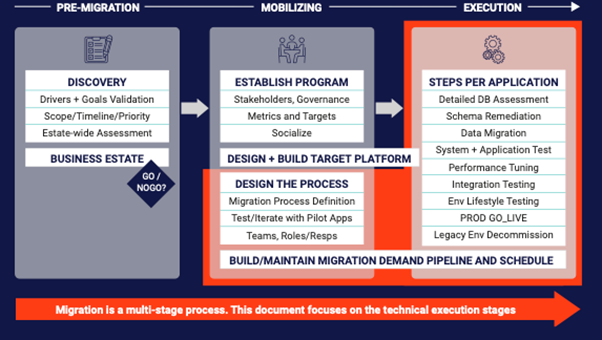Beyond the technical considerations for a database migration it is critical to understand how to manage what is effectively a transformation exercise at scale
1 Introduction
The migration of legacy databases to Postgres represents a significant shift in an organization's data management strategy. At scale, this transition is not solely a technical endeavor but also a comprehensive change management exercise. In addition to a strong technical foundation consisting of both the target Postgres platform and the tooling to execute the migration, this exercise requires rigorous planning, stakeholder engagement, and the implementation of robust processes to ensure a smooth and successful migration.
As with most large scale change exercises, at EDB we look at this in three primary phases:
- Pre-Migration
- (Program) Mobilization
- Execution

This document focuses primarily on the non technical aspects of the change and outlines our EDB methodology and best practices to ensure success.
2 Pre-Migration
The Pre-Migration phase is foundational, setting the stage for a successful migration. It involves understanding the driving forces behind the migration, establishing clear goals, timelines, and conducting initial assessments. This phase culminates in the development of a business case and a go-no go decision based on the findings.
2.1 Discovery
- Drivers: Identify and document the reasons prompting the migration. Common drivers include the need for improved performance, scalability, cost savings, flexibility to deploy on the platform of choice, and enhanced features not available in the current system.
- Goals: Define Specific, Measurable, Achievable, Relevant, and Time-bound (SMART) goals for the migration to ensure all stakeholders have aligned expectations. Get agreement on those goals and make sure they align with the company’s and the participating departments’ objectives.
- Timeline: Develop a realistic timeline for the migration, considering the complexity of the legacy systems, data volume, and available resources.
- Initial Assessments: Conduct technical and organizational assessments to understand the current landscape, including database schema, data volume, dependencies, and potential challenges.
2.2 Business Case & Go-No Go Decision
- Business Case: Prepare a comprehensive business case highlighting the benefits, costs, risks, and opportunities associated with the migration. This should include an analysis of return on investment (ROI) and impact on operations.
- Go-No Go Decision: Based on the business case, make an informed decision to proceed with the migration. This decision should be taken by key stakeholders based on predefined criteria.
3 Mobilizing
The Mobilization phase is about laying the groundwork for the migration by ensuring organizational readiness. This involves securing support, engaging stakeholders, building the new platform, and developing a detailed migration process and pipeline.
3.1 Support and Stakeholder Engagement
Databases do not exist in a vacuum. They are part of your application estate and naturally it is critical that your application teams are onboard
- Securing Support: Ensure executive sponsorship and cross-functional support to champion the migration project.
- Stakeholder Engagement: Identify and engage all relevant stakeholders, including IT staff, business users, and external partners. Depending on your Organization think about any governance you need in place to oversee commitment & funding of the exercise.
- Socialize: Ensure the organization understands why your Company is undertaking the exercise, the timeline and urgency as appropriate. Develop a communication plan to keep stakeholders informed and motivated throughout the migration process.
- Operationalize: Put a program team in place to secure the above and operationalize the process and manage on an ongoing basis.
3.2 Building the New Platform
- Holistic DB platform ……
- Infrastructure: Set up the necessary infrastructure and automation for Postgres, considering hardware, software, and network requirements.
- Security and Compliance: Implement security measures and ensure compliance with relevant regulations and standards.
3.3 Building the Migration Process and Pipeline
- Migration Process: Design a detailed migration process that outlines each step, from how application teams can engage, what is expected of them, the people / teams involved and their roles & responsibilities, process steps to be followed and the tooling required to facilitate / support the process.
- Pipeline of Migrations: Develop a pipeline that schedules and tracks the progress of multiple migrations, ensuring resources are optimally allocated and dependencies are managed.
4 Execution
The Execution phase focuses on carrying out the migration according to the plan and typically involves initial migrations in development, testing, performance tuning, sign-offs and then orchestrated migration to higher life-cycle environments culminating in a Production go-live, not forgetting subsequent decommissioning of the legacy database infrastructure post successful go-live.
Specific technical tools, approaches and processes are out of scope of this document. Instead we focus here on progress monitoring and pipeline management to sustain the program and achieve the long term goals.
4.1 Progress Monitoring
- Tracking: Implement tools and procedures to monitor the progress of each migration, identifying any deviations from the plan.
- Reporting: Regularly report progress to stakeholders, highlighting achievements, challenges, and adjustments to the timeline or resources as needed. Regular executive steering committee meetings have proven to be a useful tool to maintain enterprise level commitment to this kind of a change management program.
4.2 Pipeline Management
- Coordination: Ensure smooth coordination between different migration teams and processes to avoid bottlenecks and ensure the timely completion of the migration.
- Adjustments: Be prepared to make adjustments to the migration pipeline in response to technical challenges, resource constraints, or changing business requirements.
5 Conclusion
Migrating from legacy databases to Postgres is a complex process that extends beyond technical considerations to encompass a broad spectrum of change management activities. By carefully planning and executing each phase of the migration, organizations can minimize disruptions, engage stakeholders effectively, and realize the full benefits of Postgres. Success in this endeavor requires a balanced focus on technical precision, strategic planning, and proactive stakeholder management.
